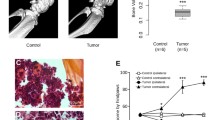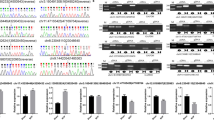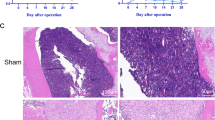Abstract
Altered expression of circular RNA (circRNA) is recognized as a contributor to malignant pain where microRNA (miRNA) exerts an essential effect. We generated a murine model for bone malignancy pain in which 2472 osteolytic sarcoma cells were injected into the femurs of mice. CircRNA microarray and quantitative PCR (qPCR) and revealed that circ9119 expression was repressed in the spinal cord of bone malignancy pain model mice, which is the first relay site involved in the transmission of nociceptive information to the cerebrum of mice that receive spinal analgesics for malignancy pain. Overexpression of circ9119 by plasmid injection in the model mice reduced progressive thermal hyperalgesia and mechanical hyperalgesia. Bioinformatics prediction and dual-luciferase reporter assay showed that circ9119 functions as a sponge of miR-26a, which targets the TLR3 3′-untranslated region. Furthermore, expression of miR-26a was elevated and TLR3 level was repressed in bone malignancy pain model mice, which were counteracted by circ9119 in the spinal cord of tumor-bearing mice. Moreover, excessive expression of miR-26a was involved in the recovery of mice from progressive thermal hyperalgesia and mechanical hyperalgesia triggered via circ9119. TLR3 knockdown in bone malignancy pain model mice thoroughly impaired pain in the initial stages and reduced the effects of circ9119 on hyperalgesia. Our research findings indicate that targeting the circ9119-miR-26a-TLR3 axis may be a promising analgesic strategy to manage malignancy pain.






Similar content being viewed by others
Change history
11 November 2019
The original version of this article unfortunately contained a mistake in Fig. 2.
01 September 2020
The authors have retracted this article [1] because in further experiments, they found that some experimental data cannot be verified repeatedly.
References
Chen I, Chen CY, Chuang TJ (2015) Biogenesis, identification, and function of exonic circular RNAs. Wiley Interdiscip Rev RNA 6:563–579. https://doi.org/10.1002/wrna.1294
Chen W, Lu Z (2017) Upregulated TLR3 promotes neuropathic pain by regulating autophagy in rat with L5 spinal nerve ligation model. Neurochem Res 42:634–643. https://doi.org/10.1007/s11064-016-2119-2
Coleman RE (1997) Skeletal complications of malignancy cancer: interdisciplinary. Int J Am Cancer Soc 80:1588–1594
Coyle N, Adelhardt J, Foley KM, Portenoy RK (1990) Character of terminal illness in the advanced cancer patient: pain and other symptoms during the last four weeks of life. J Pain Symptom Manag 5:83–93
Ding K et al (2017) MiR-26a performs converse roles in proliferation and metastasis of different gastric cancer cells via regulating of PTEN expression. Pathol Res Pract 213:467–475. https://doi.org/10.1016/j.prp.2017.01.026
Ebbesen KK, Kjems J, Hansen TB (2016) Circular RNAs: identification, biogenesis and function. Biochim Biophys Acta 1859:163–168. https://doi.org/10.1016/j.bbagrm.2015.07.007
Elramah S et al (2017) Spinal miRNA-124 regulates synaptopodin and nociception in an animal model of bone cancer pain. Sci Rep 7:10949
Fujii T, Shimada K, Nakai T, Ohbayashi C (2018) MicroRNAs in smoking-related carcinogenesis: biomarkers, functions, and therapy. J Clin Med:7. https://doi.org/10.3390/jcm7050098
Gandla J, Lomada SK, Lu J, Kuner R, Bali KK (2017) miR-34c-5p functions as pronociceptive microRNA in cancer pain by targeting Cav2. 3 containing calcium channels. Pain 158:1765
Hansen TB, Jensen TI, Clausen BH, Bramsen JB, Finsen B, Damgaard CK, Kjems J (2013) Natural RNA circles function as efficient microRNA sponges. Nature 495:384
Hargreaves K, Dubner R, Brown F, Flores C, Joris J (1988) A new and sensitive method for measuring thermal nociception in cutaneous hyperalgesia. Pain 32:77–88
Hayes J, Peruzzi PP, Lawler S (2014) MicroRNAs in cancer: biomarkers, functions and therapy. Trends Mol Med 20:460–469. https://doi.org/10.1016/j.molmed.2014.06.005
Hsieh CH et al (2017) Knockout of toll-like receptor impairs nerve regeneration after a crush injury. Oncotarget 8:80741–80756. https://doi.org/10.18632/oncotarget.20206
Jeck WR et al. (2013) Circular RNAs are abundant, conserved, and associated with ALU repeats RNA 19:141-157 doi:https://doi.org/10.1261/rna.035667.112
Jiang C et al (2014b) MicroRNA-26a negatively regulates toll-like receptor 3 expression of rat macrophages and ameliorates pristane induced arthritis in rats. Arthritis Research & Therapy 16:R9
Jiang D-S, Wang Y-W, Jiang J, Li S-M, Liang S-Z, Fang H-Y (2014a) MicroRNA-26a involved in toll-like receptor 9-mediated lung cancer growth and migration. Int J Mol Med 34:307–312
Lacagnina MJ, Watkins LR, Grace PM (2018) Toll-like receptors and their role in persistent pain. Pharmacol Ther 184:145–158. https://doi.org/10.1016/j.pharmthera.2017.10.006
Livak KJ, Schmittgen TD (2001) Analysis of relative gene expression data using real-time quantitative PCR and the 2− ΔΔCT method methods 25:402–408
Lopez-Urrutia E et al (2017) MiR-26a downregulates retinoblastoma in colorectal cancer. Tumour Biol 39:1010428317695945. https://doi.org/10.1177/1010428317695945
Luger NM et al (2001) Osteoprotegerin diminishes advanced bone cancer pain. Cancer Res 61:4038–4047
Mei X-P, Zhou Y, Wang W, Tang J, Wang W, Zhang H, Xu LX, Li YQ (2011) Ketamine depresses toll-like receptor 3 signaling in spinal microglia in a rat model of neuropathic pain. Neurosignals 19:44–53
Mercadante S (1997) Malignant bone pain: pathophysiology and treatment. Pain 69:1–18
Njoo C, Heinl C, Kuner R (2014) In vivo SiRNA transfection and gene knockdown in spinal cord via rapid noninvasive lumbar intrathecal injections in mice JoVE (Journal of Visualized Experiments):e51229
Portenoy RK, Lesage P (1999) Management of cancer pain. Lancet 353:1695–1700
Qi J et al (2011) Painful pathways induced by TLR stimulation of dorsal root ganglion neurons. J Immunol (Baltimore, Md : 1950) 186:6417–6426. https://doi.org/10.4049/jimmunol.1001241
Reuland SN et al (2013) MicroRNA-26a is strongly downregulated in melanoma and induces cell death through repression of silencer of death domains (SODD). J Investig Dermatol 133:1286–1293
Rizzo M et al (2017) Discovering the miR-26a-5p targetome in prostate cancer cells. J Cancer 8:2729–2739. https://doi.org/10.7150/jca.18396
Rybak-Wolf A, Stottmeister C, Glažar P, Jens M, Pino N, Giusti S, Hanan M, Behm M, Bartok O, Ashwal-Fluss R, Herzog M, Schreyer L, Papavasileiou P, Ivanov A, Öhman M, Refojo D, Kadener S, Rajewsky N (2015) Circular RNAs in the mammalian brain are highly abundant, conserved, and dynamically expressed. Mol Cell 58:870–885. https://doi.org/10.1016/j.molcel.2015.03.027
Sabino MAC et al. (2002) Simultaneous reduction in cancer pain, bone destruction, and tumor growth by selective inhibition of cyclooxygenase-2 62:7343-7349
Schwei MJ, Honore P, Rogers SD, Salak-Johnson JL, Finke MP, Ramnaraine ML, Clohisy DR, Mantyh PW (1999) Neurochemical and cellular reorganization of the spinal cord in a murine model of bone cancer pain. J Neurosci 19:10886–10897
Tétreault P, Dansereau M-A, Doré-Savard L, Beaudet N, Sarret P (2011) Weight bearing evaluation in inflammatory, neuropathic and cancer chronic pain in freely moving rats. Physiol Behav 104:495–502
Zhang L et al (2018a) CircRNA-9119 regulates the expression of prostaglandin-endoperoxide synthase 2 (PTGS2) by sponging miR-26a in the endometrial epithelial cells of dairy goat. Reprod Fertil Dev. https://doi.org/10.1071/RD18074
Zhang L et al (2018b) CircRNA-9119 regulates the expression of prostaglandin-endoperoxide synthase 2 (PTGS2) by sponging miR-26a in the endometrial epithelial cells of dairy goat. 30:1759–1769
Zhang Y et al (2015) MicroRNA-26a prevents endothelial cell apoptosis by directly targeting TRPC6 in the setting of atherosclerosis. Sci Rep 5:9401
Acknowledgments
This work was supported by the Key Specialist Project of Clinical Medicine of Foshan City (Grant Number FSZDZK135049); Distinguished Youth Talent Fund Project of the First Medical Science Center of Foshan City in 2018; and Guangdong Medical Research Fund Project in 2019 (Grant Number A2019045). We thank Edanz Group (www.edanzediting.com/ac) for editing a draft of this manuscript.
Author information
Authors and Affiliations
Corresponding authors
Ethics declarations
This study was approved by the Committee on the Ethics of Animal Experiments of Shunde Hospital of Southern Medical University.
Conflict of Interest
The authors declare that they have no conflict of interest.
Additional information
Publisher’s Note
Springer Nature remains neutral with regard to jurisdictional claims in published maps and institutional affiliations.
The original version of this article was revised: The authors found some inaccurate information in Figure 2 after repeated experiments. The figure is now replaced with the correct version.
About this article
Cite this article
Zhang, Z., Zhang, X., Zhang, Y. et al. RETRACTED ARTICLE: Spinal circRNA-9119 Suppresses Nociception by Mediating the miR-26a-TLR3 Axis in a Bone Cancer Pain Mouse Model. J Mol Neurosci 70, 9–18 (2020). https://doi.org/10.1007/s12031-019-01378-w
Received:
Accepted:
Published:
Issue Date:
DOI: https://doi.org/10.1007/s12031-019-01378-w




